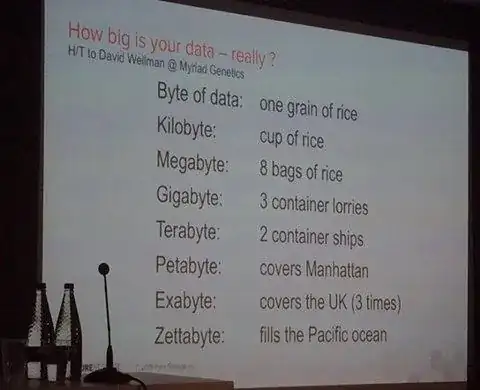The rice here is an analogy, not an actual way to measure data
If you do a search for "David Wellman Myriad Genetics presentation", you can easily find a link to the presentation he gave, though this particular image comes from a different presentation. Wellman's presentation was about "Big Data", the term used in reference to companies trying to figure out how make sense of the massive amounts of data they have, often terabytes or petabytes of it.
This image purports that you can measure data in grains of rice
That's not what the image is talking about - rice is being used here as an analogy. Thanks to better manufacturing, computers have been getting smaller even while the data they store has been increasing, so it's easy to hear "one terabyte" and not really understand the scale of how much data there is. Wellman was trying to help his audience understand the scale of problem.
For example, suppose a company has a petabyte of data that they are wanting to extract useful information from. To understand the scale of this problem you can think of it as if they were trying to search through a rice-covered Manhattan in order to find the information they need.
If you're still wondering about how accurate the numbers are, let's pull some numbers from Wikipedia's Orders of magnitude (volume) page to get numbers for the first two points (volumes are in cubic meters):
7×10−8 Volume of a large grain of rice 3 mm wide by 12 mm long
4.73×10−4 One US liquid pint
7×10-8 times 1000 is 0.7×10-4, while one cup (half of a pint) is 2.36×10-4. It's not perfect, but it's close enough for us to assume that either (1) the author used slightly different numbers or (2) the author didn't care about perfect accuracy.
Looking at another pair, Manhattan covers 59.1 km2 of land, while the UK covers 240,000 km2 of land. Here the numbers are a little off - the UK covers about 4000x the area of Manhattan, so unless Manhattan was actually being covered 12 times, the UK would not actually be fully covered three times.
In both of these cases, it doesn't matter that the numbers might be a little off - rice is being used as an analogy so perfect accuracy isn't necessary.
